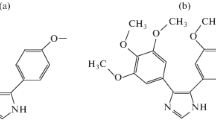Abstract
Fully bio-based chitosan derivative was synthesized using 3-benzyl-2,5-diketopiperazine-6-acetic acid (DKP) activated by 1-(3-dimethylaminopropyl)-3-ethylcarbodiimide hydrochloride and N-hydroxysuccinimide. From IR and 1H NMR spectra, the structure of the bioconjugated chitosan and the quantitative modification were confirmed. Oil-in-water (o/w) emulsion of the obtained product was presented with the various ratios of water and benzene solution. Continuously the obtained o/w emulsions were freeze-dried to produce the mesoporous sponge, depended on the ratio of the water and benzene. These amphiphilic properties were observed by the property of the pendant DKP moieties in chitosan. The pore size in the sponges was controlled in a range from 0.1 to 0.3 μm by changing the solvent ratios.






Similar content being viewed by others
References
Södergård A, Stolt M (2002) Properties of lactic acid based polymers and their correlation with composition. Prog Polym Sci 27:1123–1163
Auras R, Harte B, Selke S (2004) An overview of polylactides as packaging materials. Macromol Biosci 4:835–864
Rezwan K, Chen QZ, Blaker JJ, Boccaccini RA (2006) Biodegradable and bioactive porous polymer/inorganic composite scafforlds for bone tissue engineering. Biomaterials 27:3413–3431
Lim L-T, Auras R, Rubino M (2008) Processing technologies for poly(lactic acid). Prog Polym Sci 33:820–852
Fundador NG, Enomoto-Rogers Y, Takemura A, Iwata T (2012) Acetylation and characterization of xylan from hardwood kraft pulp. Carbohydr Polym 87:170–176
Fundador NG, Enomoto-Rogers Y, Takemura A, Iwata T (2012) Synthesis and characterization of xylan esters. Polymer 53:3885–3893
Enomoto-Rogers Y, Iio N, Takemura A, Iwata T (2015) Synthesis and characterization of pullulan alkyl esters. Eur Polym J 66:470–477
Heinze T, Liebert T (2001) Unconventional methods in cellulose functionalization. Prog Polym Sci 26:1689–1762
Klemm D, Heublein B, Fink H-P, Bohn A (2005) Cellulose: fascinating biopolymer and sustainable raw material. Angew Chem Int Ed 44:3358–3393
Köhler S, Liebert T, Schöbitz M, Schaller J, Meister F, Günther W, Heinze T (2007) Interactions of ionic liquids with polysaccharides 1. Unexpected acetylation of cellulose with 1-ethylimidazorium acetate. Macromol Rapid Commun 28:2311–2317
Xu D, Li B, Tate C, Edgar KJ (2011) Studies on regioselective acetylation of cellulose with bulky acid chlorides. Cellulose 18:405–419
Elschner T, Heinze T (2014) A promising cellulose-based polyzwitterion with pH-sensitive charges. Beilstein J Org Chem 10:1549–1558
Dong Y, Edgar KJ (2015) Imparting functional variety to cellulose via olefin cross-methathesis. Polym Chem 6:3816–3827
Liu S, Liu J, Esker AR, Edgar KJ (2016) An efficient, regioselective pathway to cationic and zwitterionic N-heterocyclic cellulose ionomers. Biomacromolecules 17:503–513
Gaines SM, Bada JL (1988) Aspartame decomposition and epimerization in the diketopiperazine and dipeptide products as a function of pH and temperature. J Org Chem 53:2757–2764
Butchko HH, Stargel WW, Comer CP, Mayhew DA, Benninger C, Blackburn GL, Sonneville LMJ, Geha RS, Hetelendy Z, Koestner A, Leon AS, Liepa GU, McMartin KE, Mendenhall CL, Munro IC, Novotny EJ, Renwick AG, Schiffman SS, Schomer DL, Shaywits BA, Spiers PA, Tephly TR, Thomas JA, Trefz FK (2002) Aspartame: review of safety. Regul Toxicol Pharmacol 35:S1–S93
Boni SD, Oberthür C, Hamburger M, GKE S (2004) Analysis of aspartyl peptide degradation products by high-performance liquid chromatography and high-performance liquid chromatography-mass spectrometry. J Chromatogr A 1022:95–102
Stark T, Hofmann T (2005) Structures, sensory activity, and dose/response functions of 2,5-diketopiperazines in roasted cocoa nibs (Theobroma cacao). J Agric Food Chem 53:7222–7231
Mellini P, Kokkola T, Suuronen T, Salo HS, Tolvanen L, Mai A, Lahtela-Kakkonen M, Jarho E (2013) Screen of pseudopeptidic inhibitors of human sirtuins 1-3: two lead compounds with antiproliferative effects in cancer cells. J Med Chem 56:6681–6695
Hanabusa K, Matsumoto M, Kimura M, Kakehi A, Shirai H (2000) Low molecular weight gelators for organic fluids: gelation using a family of cyclo(dipeptide)s. J Colloid Interface Sci 224:231–244
Yamg Y, Fukui H, Suzuki F, Shirai H, Hanabusa K (2005) Preparation of silica nanosprings using cationic gelators as template. Bull Chem Soc Jpn 78:2069–2074
Hoshizawa H, Suzuki M, Hanabusa K (2011) Cyclo(L-aspartyl-L-phenylalanyl)-containing poly(dimethylsiloxane)-based thixotropic organogels. Chem Lett 40:1143–1145
Hoshizawa H, Minemura Y, Yoshikawa K, Suzuki M, Hanabusa K (2013) Thixotropic hydrogelators based on a cyclo(dipeptide) derivative. Langmuir 29:14666–14673
Hanabusa K, Takata S, Fujisaki M, Nomura Y, Suzuki M (2016) Fluorescent gelators for detection of explosives. Bull Chem Soc Jpn 89:1391–1401
Rinaudo M (2006) Chichin and chitosan: properties and applications. Prog Polym Sci 31:603–632
Racine L, Texier I, Auzély-Velty R (2017) Chitosan-based hydrogels: recent design concepts to tailor properties and functions. Polym Int 66:981–998
Fonseca-Santos B, Chorilli M (2017) An overview of carboxymethyl derivatives of chitosan: their use as biomaterials and drug delivery systems. Mater Sci Eng C 77:1349–1362
Verlee A, Mincke S, Stevens CV (2017) Recent developments in antibacterial and antifungal chitosan and its derivatives. Carbohydr Polym 164:268–283
Heras A, Rodríguez NM, Ramos VM, Agulló E (2001) N-methylene phosphonic chitosan: a novel soluble derivative. Carbohydr Polym 44:1–8
Ramos VM, Rodríguez NM, Díaz MF, Rodríguez MS, Agulló E (2003) N-methylene phosphonic chitosan. Effect of preparation methods on its properties. Carbohydr Polym 52:39–46
Holme KR, Hall LD (1991) Chitosan derivatives bearing C10-alkyl glucoside branches: a temperature-induced gelling polysaccharide. Macromolecules 24:3828–3833
Ramos VM, Rodríguez NM, Díaz MF, Rodríguez MS, Agulló E (2003) Modified chitosan carrying phosphonic and alkyl groups. Carbohydr Polym 51:425–429
Acknowledgments
This work has been financially supported mainly by Advanced Low Carbon Technology Research and Development Program (5100270) (JST-ALCA) and partially by Center of Innovation (COI) program “Construction of next-generation infrastructure using innovative materials – Realization of a safe and secure society that can coexist with the earth for centuries – supported by MEXT and JST”.
Author information
Authors and Affiliations
Corresponding author
Additional information
This article is part of the Topical Collection on Bio-Based Polymers
Rights and permissions
About this article
Cite this article
Takada, K., Yin, H., Matsui, T. et al. Bio-based mesoporous sponges of chitosan conjugated with amino acid-diketopiperazine through oil-in-water emulsions. J Polym Res 24, 216 (2017). https://doi.org/10.1007/s10965-017-1372-7
Received:
Accepted:
Published:
DOI: https://doi.org/10.1007/s10965-017-1372-7




